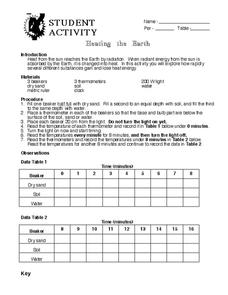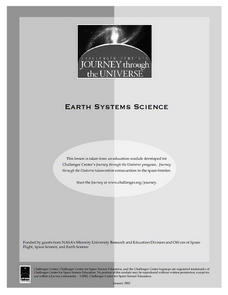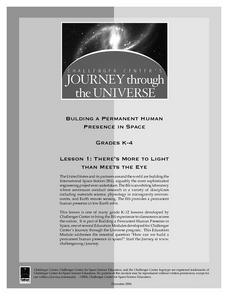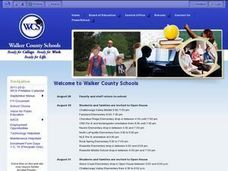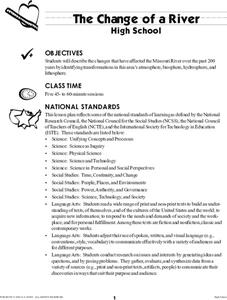Curated OER
The Tropopause
In this tropopause worksheet, students read about the temperature of the air in the tropopause or the layer of the atmosphere closest to the Earth. They answer four critical thinking questions about this layer and the energy changes that...
Curated OER
Bellwork for Week 15-Climate
In this bellwork worksheet, students answer questions about the layers of the atmosphere, the composition of the atmosphere and the weather and the climate.
Curated OER
Aerosol Science
In this aerosol activity, students are given data for volcanic eruptions and the average temperatures of the Earth. They determine the change in temperature from the year of the eruption to the present year and use the means to determine...
Curated OER
The Impact of Human or Natural Events on the Spheres
In this hydrosphere and atmosphere activity, students work in groups to present an assigned topic's effects on the atmosphere and the hydrosphere. They identify the topic as human activity or natural activity and it's impact.
Curated OER
Layers of the Atmosphere Activity
For this layers of the atmosphere worksheet, students paste labels for each layer of the atmosphere on a diagram and they add pictures of objects that belong in each layer. They answer questions about the main layers, they determine...
Curated OER
Changes in the Atmosphere or Hydrosphere
In this atmosphere and hydrosphere worksheet, students work on assigned topic which are either categorized as human activity or natural activity which impact the atmosphere and the hydrosphere. Students work in groups and answer...
Curated OER
The Composition of the Atmosphere
In this atmosphere worksheet, students identify the major components of the earth's atmosphere and write the percentage of each. They also fill in a pie graph of the percent composition of the atmosphere and answer questions about air.
Curated OER
Moon Crash
In this moon crash worksheet, students research information about the moon. In a given scenario, students decide which emergency supplies to take in order to survive on the moon.
Curated OER
Environmental Issues
In this environmental issues worksheet, students respond to 14 different types of questions divided into 3 sections. First, they define global warming and give an example of what they can do to slow it. Then, students define 4 terms...
Curated OER
Solar System Planet Research
For this space science worksheet, students collect data that includes information in a chart or graph to display in a group. They identify and describe various planet features of a specific planet of choice. Students write notes and the...
Curated OER
Gases In The Atmosphere
In this science worksheet, learners look for the amounts of air composition in the atmosphere by filling in the three different data charts.
Curated OER
Heating The Atmosphere
In this science worksheet, students look for the answers to finding the correct temperatures that match the location in the atmosphere.
Curated OER
The History of Climate Change
In this science worksheet, students gather in-depth information dealing with climate change over the next century. They analyze the grid to determine the average time difference between peaks in the temperature history for the last...
Curated OER
Ozone and Temperature Data Analysis, South Pole Antarctica
Students discuss the layers of the atmosphere, and the history of the ozone hole. They discuss the chemistry of the ozone formation. Students compare seasonal data collected with ozonesondes. They compare Antarctic and Arctic ozone hole...
Curated OER
Rust Never Sleeps
High schoolers investigate oxidation-reduction reactions involving iron by conducting an experiment in which they expose iron filings to different atmospheric and ocean conditions. They relate the results to the oxidation banding...
Curated OER
There's More to Light than Meets the Eye
Students explore the concept that not all light is visible to the
human eye. Although UV light is not visible, it can still be harmful, causing sunburns or skin cancer. They use special beads to detect UV light around the school....
Curated OER
Weather
Students explore the earth's atmosphere, weather, and climate. They begin class with a discussion about weather patterns, atmosphere, and the layers of the earth. After the class discussion, students rotate through four stations to...
Curated OER
Ecology 5 - Carbon and Oxygen Cycles
High schoolers construct their own diagrams outlining the pathway of carbon and oxygen in our atmosphere. They listen to a lecture on the carbon cycle while drawing an example of the carbon cycle on the board. Students comprehend that...
Curated OER
Make Acid Rain
Students create models of the earth's atmosphere to explore how gases that are dissolved in water can eventually create acid rain. After conducting a series of experiments within their models of the earth's atmosphere, students analyze...
Curated OER
TE Lesson: Pollution Solutions
Learners study how industrial technology helps clean up and prevent air pollution. They role play as engineers to examine methods of engineering pollutant recovery methods such as scrubbers, electrostatic precipitators, cyclones, and...
Curated OER
What's Air Got to Do with It?
Young scholars use M&M's to create a pie graph that expresses their understanding of the composition of air. They watch and conduct several simple experiments to develop an understanding of the properties of air (it has mass, it...
Curated OER
Environment: Battling for Oxygen
Students construct an interactive ozone depletion model using gumdrops and toothpicks. After analyzing the data obtained from the model, they record it on butcher paper and complete worksheets about oxygen.
Curated OER
Global Warming: Life in a Greenhouse
Students examine the evidence that scientists have used to support the existence of global warming and the greenhouse effect. How the concepts have been developed and evaluated form the focus of this lesson.
Curated OER
The Change of a River
High schoolers describe the changes that have affected the Missouri River over the past 200 years by identifying transformations in this area's atmosphere, biosphere, hydrosphere, and lithosphere. They research online in groups assigned...













